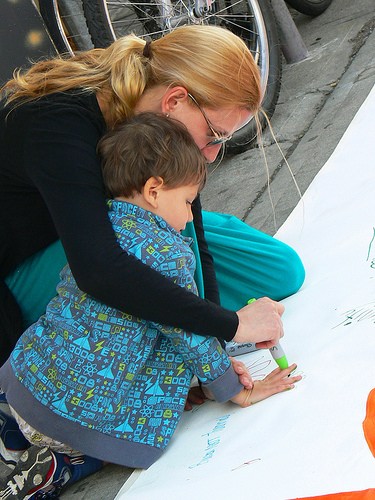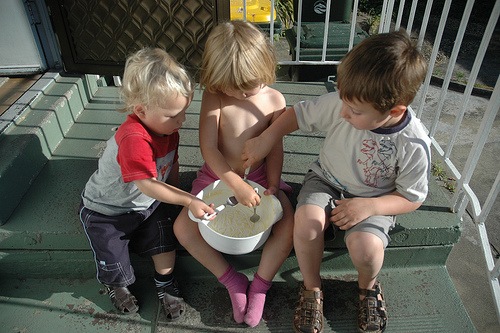How do you know what a fork is for?
Surely when you look at how it’s structured, you could guess what sorts of things it could do. It could beat eggs, help make a piecrust, comb hair, or even scratch your back. But somehow you learn that forks are “for” eating.
A fork is just one of the many "designed objects" that we find in our everyday environment, as engineer Henry Petroski noted. Forks assist in eating – and cars enable us to get to places quickly, hammers help us build things, and so on.
But objects are more than just their form and function. A closer look at these common objects reveals that they carry meanings and they tell stories – shared stories about who we are as humans and communities.
Scholars in a number of fields study the relationship between objects and people. The fields of archaeology, material culture, and product design come to mind.
As a developmental psychologist, my angle is the individual person, with a focus on the developing child. I ask: how does a child, born into a community surrounded with designed objects, learn to understand what these many objects are and how to use them?
Learning about objects is learning about sharing. When you think of sharing, the first thing that might come to mind is children learning to share their toys and belongings with others.

But I would like to discuss a different take on sharing – the sharing of knowledge and beliefs about objects. During their preschool to early school years, children are beginning to learn about the shared nature of objects. Our knowledge and beliefs about objects can be considered to be shared in a number of ways.
Shared Expertise
Objects are made by people – often by designers, people with expertise in creating something to suit a particular activity.
For example, an effective fork needs to be made of a material that is strong enough for eating. It should have a shape that makes it easy to hold, with sharp prongs to effectively pierce and pick up food, and a nice curve to make placing into the mouth easy. When you see such an object, you may analyze its form and infer that it was intentionally made for eating – and so that’s what it’s for.
Research has suggested that children from around 4-5 years old seem to understand that objects are designed for certain functions and will use and/or understand objects accordingly.
So if an object, such as a chair, is designed for sitting, research shows that even if they see someone use it as a table, children will still think of the chair as for sitting.

Shared Community Knowledge and Beliefs
Objects reflect the kinds of activities communities tend to engage in.
For instance, we have mailboxes because communicating through letters is something that we do. Communities share knowledge and beliefs about what objects are used for in various activities. So, though a chair could be used as a dining table, not only is the chair not designed for this function, but communities do not commonly accept it for this function.
However, sometimes a community’s shared beliefs about what an object can be used for may differ from the designer’s intended use and may still become acceptable.
Take the fork. It is not designed to beat eggs, but as a community we have come to accept this as a valid function. In my research, children as young as 5 years old seem to understand not only that the designer plays a role in deciding what an object is for, but also that we as a community can come to an agreement to decide it’s for something else. Users and designers collaborate in creating a story for the object.
But how do children learn what their community thinks?

Currently, I am investigating how children in the course of their day-to-day lives learn about object use. Specifically, I am looking at how parents share their community’s knowledge and beliefs about objects and their uses with their children during everyday activities, such as cooking. Do parents suggest that it is equally ok to use a whisk or a fork or a cocktail stirrer to beat eggs? When it comes to cutting biscuits out of dough, is it just as okay to use a water glass or a jar lid as it is to use a biscuit cutter?
During everyday activities and interactions, children are learning important information about their community’s shared knowledge and beliefs about objects. And through the process of being guided into the shared knowledge of their community, they are also learning what it means to share and be part of a larger community.
 Sharing Across Generations
Sharing Across Generations
The objects we use now in our daily activities should not be seen as isolated in time, but rather as building on past community objects and knowledge.
Many of the objects we use now to beat eggs, transport us, or write with, are adaptations of previous objects used by past generations and communities. For example, the modern pen is an adaptation of older writing implements such as the quill and ink. So we not only share knowledge about objects with our current community – we also share and build upon community knowledge across time.
Individual Contributions, Shared Knowledge
So we have a picture of several ways that learning about objects is learning about sharing.
However, we are not just learning what the designer intended and how the community and past communities have actually used an object. We as individuals are also continuously, creatively adapting objects for our own needs and we are using objects in ways neither the designer nor our community ever anticipated. In college I used my boot as a hammer to put together my bookshelf. I also saw some college students using a fork as a doorstop. I’m sure you have used or have seen others using objects in all sorts of different and “incorrect” ways.
While children are being guided into a shared way of understanding and using objects, they are also learning that they too can contribute to this shared knowledge.
 For instance, in my current study I observed a parent and her 5-year-old son having a difficult time deciding what object to use to beat eggs for their omelet. In the box of objects that I provided for the activity, the only object they had for beating eggs was a long (and quite effective) cocktail stirrer.
For instance, in my current study I observed a parent and her 5-year-old son having a difficult time deciding what object to use to beat eggs for their omelet. In the box of objects that I provided for the activity, the only object they had for beating eggs was a long (and quite effective) cocktail stirrer.
When the parent did not find a whisk in the box she came out of the kitchen, looking confused, and asked me (the researcher) for the whisk. I think she thought that we forgot to include it.
I responded that everything they needed for the activity was in the box. While she went back into the kitchen, seemingly still determined to find that whisk, her son had found the cocktail stirrer and asked his mom if they could use that. She laughed and said it wouldn’t work.
The boy appeared confused and proceeded to use it anyway. He then tried to convince his mom, who was still looking through the box determined to find the “right” object, that it worked and they should use it.
Ultimately, the parent saw that the stirrer actually was working. She appeared surprised – but then accepted the object for this function.
Sharing is part of who we are as humans. Even in our understanding and use of the common objects that surround us we are sharing – sharing our knowledge, experiences, and beliefs.

And children, born into communities with object-filled environments, have the task of learning about sharing. They learn that experts share their own knowledge and expertise about objects. They learn, through the guidance of parents and others, that their community shares knowledge and beliefs about objects. Through this process of learning about sharing, children might learn that forks as well as whisks can be used to beat eggs.
However, children are also learning that shared knowledge is not static. They are learning that we all can contribute, even in small ways, to our ever-changing shared knowledge and beliefs about objects and their uses.
Photos in the body of the essay are by Aki Rosenberg, Natalie Kleefeld, and Tania Liu.









